ANNUAL LETTER TO CLIENTS
Greetings from Rochester. We hope you are off to as strong start in 2024 as Nvidia is.
All kidding aside, it’s been an incredible ride for the largest holding in the O’Keefe Stevens portfolio. We continue to believe in the long-term plan for the business. Balancing growth and excitement with prudent portfolio weighting continues to be a challenge. Dominick explains our struggle in his January 2024 Quarterly Investor Letter. I encourage you to check out Dom’s writing if you’re curious about our current investment thinking. Stewarding your resources requires tough decision-making. We need to keep a level head when balancing risk with reward. Our January 2024 Value Conversation Quarterly Investor Call also adds great perspective.
This update aims to restate our guiding principles and provide a market update. For new clients, we recommend repeated exposure to this messaging. Markets have been on the rise, but this too shall pass. When investor sentiment shifts to negativity, there will be fierce temptation to change course. As our long-term clients know, these periods of intense uncertainty are only temporary. “This too shall pass” needs to be our mantra through periods of market euphoria and panic alike.
We are coming off one of the best years in our partnership’s history. Peter and I are thankful for your continued trust and belief in our approach. We are grateful to those of you who have shared our story with others. Another year of financial planning, investing, and stewardship begins and we are as excited as ever. The application of a few simple concepts, without interruption, produces outstanding lifetime results. I’ve done my best to summarize these concepts in the paragraphs that follow. Please read them carefully and share them with anyone who needs to hear them. Thank you for being a part of this incredible journey with us.
General Principles
The only definition that logically applies to money is purchasing power. That is, what you can exchange for it: goods and services. The exact amount of currency, or the type, is irrelevant. It’s the value of what money buys you that matters.
The measure of how successful an investment is should be how well it grows your purchasing power. The long-term investment strategy we follow aims to accumulate purchasing power over time.
Over time, Owners of businesses (stockholders) make far greater returns than do the lenders of those businesses (bondholders). The reason is simple: if rational owners could not earn a significant return over their cost to borrow money, they would not borrow it in the first place.
This logic translates into the historical relationship between stock investors and bondholders. Net of inflation, stockholders compounded their returns by nearly 7 percent, while bondholders returned just 3% over the past century.
This would be an easy endeavor if it was not for one glaring attribute of being an owner: volatility. The price we pay for the premium results of equities is their occasional, but always temporary, drop in value. Since 1980 the S&P 500 (our proxy for public US stock companies) declined on average 14.2% annually, when looking at intra-year results. Intra-year means we measure declines from all points throughout the year. But, looking at full-year results over the same timeframe, we see that 33 of the last 44 years are positive. See this illustrated in the JP Morgan Chart below.
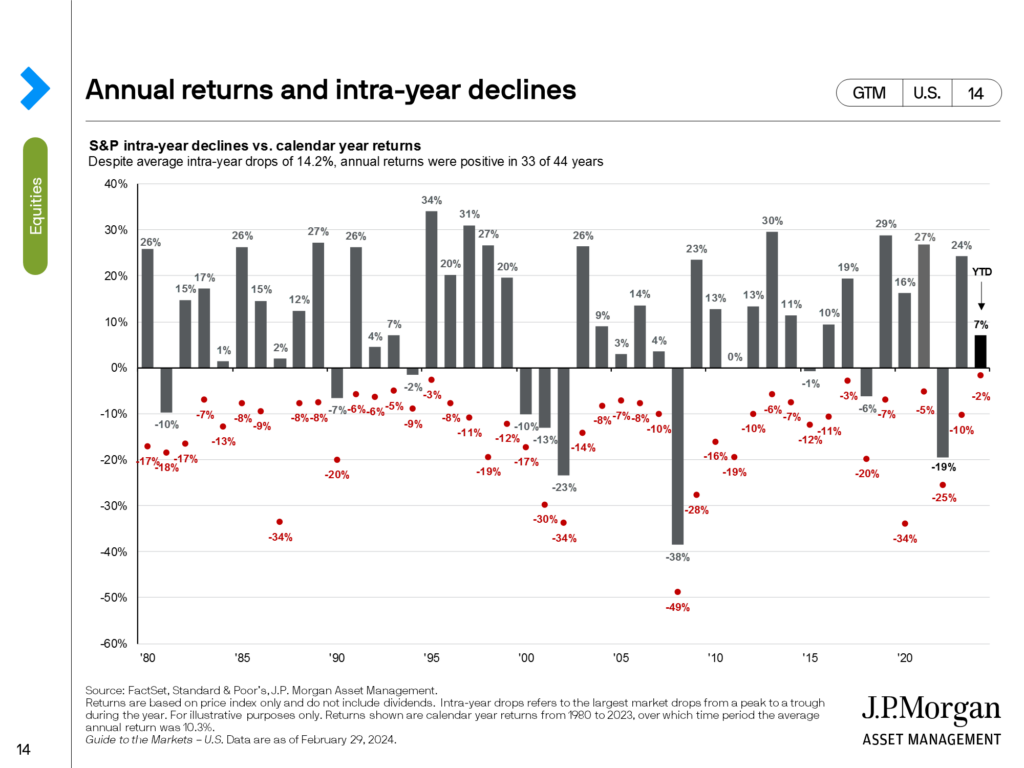
This next chart from First Trust shows this information in another way. It considers the depth and duration of bear and bull markets in the United States. You’ll see there is a big difference between the two. Bear markets do not drop as much as bull markets rise. And, they do not last as long either.
During bear markets, it appears there is no end in sight. But the light does break through the darkness at some point. And during recoveries, it seems something is always looming that could derail investors. “Climbing a wall of worry” is what stock investors call it. We don’t pretend that we can predict these swings in investor sentiment. But we know how vital it is to remind you of these lessons when fear becomes the prevailing theme of the market.
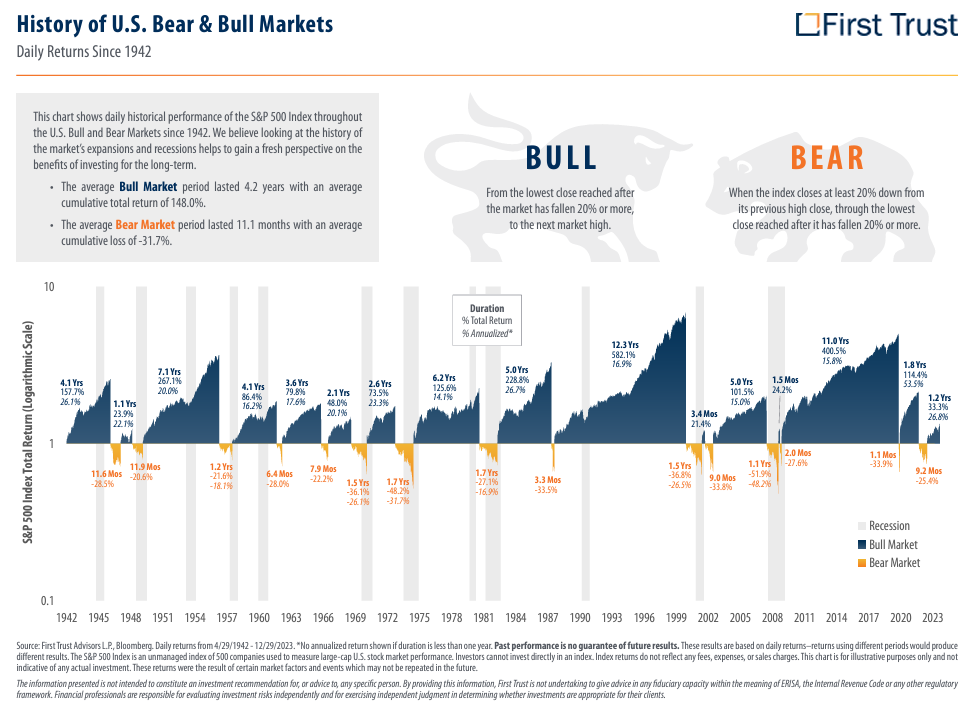
So, what is safe?
The real test of an investment’s long-term safety is its return above and beyond the rising cost of living. Rising income has most reliably been produced through the ownership of successful companies.
Take a look at what’s happened over the lives of people heading into retirement now. Since 1960, the S&P 500’s cash dividend has compounded at about three times the long-term rate of inflation. And, its value has grown by 68 times!
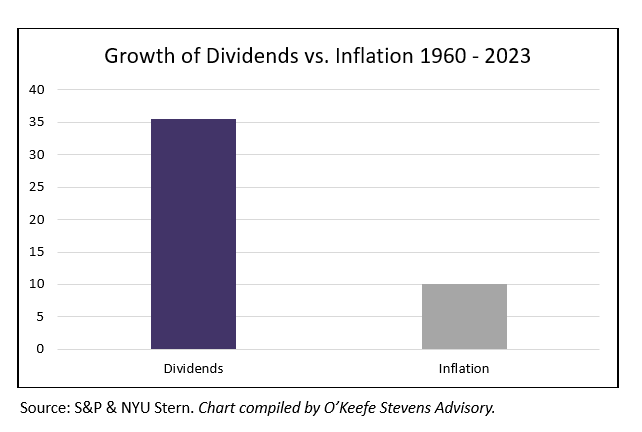
Rising equity values over long periods provide their owners with:
- More room to increase their withdrawals, and
- Built wealth they can leave to the people they love.
This is the basic premise of our investment strategy for retirement. When it’s applied consistently over your lifetime, the results are incredible. Our continued approach is to:
- Build you a date-specific/dollar-specific plan to meet your financial goals,
- Fund the plan with investments that provide the highest probability outcome for success in outpacing inflation:
- Keeping enough cash to cover near-term spending needs, and
- Allowing the rest to stay invested without unnecessary interruption.
- Provide behavioral guidance to stay the course and only change the plan when your goals change.
Simple, but not easy.
Current Thinking and Market Perspectives
The market results of the past two years are a compelling example for long-term investors. In 2022, the Dow, the S&P 500 and the Nasdaq 100 experienced peak-to-trough declines of 21%, 25%, and 35%, respectively. By the end of January 2024, all three were in new high ground.
Why stocks did this is irrelevant to the wonderful lessons to be drawn from this experience. There are almost as many theories of why this happened as there are market commentators. (I would point out, that the number of forecasters of both the 2022 decline and the 2023 recovery is, to my knowledge, zero).
What should matter most to us long-term, goal-focused, plan-driven equity investors is not why this happened but that it happened. Specifically, that there could be a pervasive and very significant bear market over most of one year, and that those declines could be entirely erased in the following year. Although not nearly as quick or as perfectly symmetrical as the 2022-23 experience, in the largest sense this is how it works.
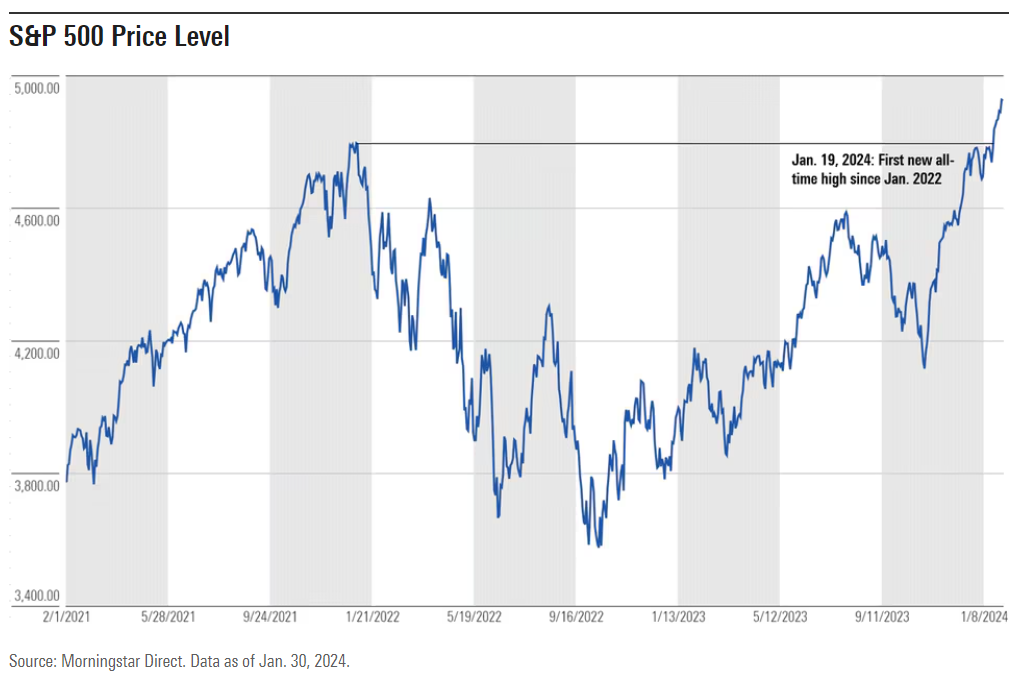
While markets may be making new highs today, the prevailing question seems to be: “is there anywhere to go but down?”
Our posture going into this year is cautiously optimistic. We had outsized results in the portfolio during 2023. In most portfolios, we carved out some profits. We are patiently holding this “dry powder” in search of new opportunities. The businesses we prefer have strong finances and experienced managers that we trust. However, they must have some temporary setback that is creating a buying opportunity. Today, these opportunities are available if we are patient.
It’s likely to be a volatile year, but maybe not in the sense that many of you think. Just because markets hit a new high in January does not mean we’re due for a drop in markets. Historically, new highs are followed by more new highs. Human nature tends to produce a herd-like mentality in the markets. When prices go up, investors are more likely to continue buying. The chart below shows how all-time highs tend to cluster. In our opinion, new highs do not foreshadow corrections.
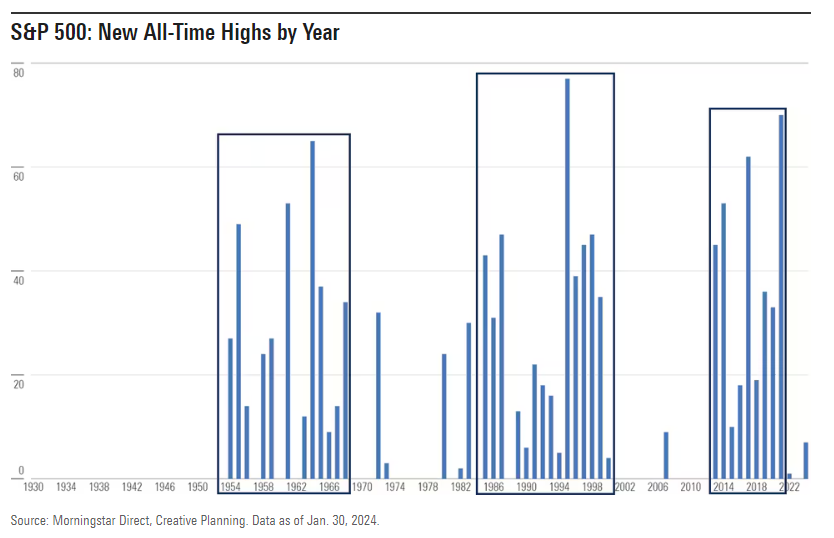
This does not mean a correction won’t happen. Refer to my intra-year chart from earlier in this post. Corrections are a common occurrence in the market. If you recognize them for what they are (temporary), then they become an opportunity. We expect there will be opportunities for the patient, long-term investor this year.
The reason for this: there continues to be many uncertainties in the world today. The long-term disruptions from the pandemic are still working themselves out. Predicting how this will impact society and the markets continues to be impossible.
The Federal Reserve’s response during the pandemic resulted in a 40% explosion in the M2 money supply. Naturally, a surge of inflation followed this surge of money entering the hands of the American consumer. Too many dollars chasing too few goods and services yields higher prices (this is all you need to know to pass Macroeconomics).
To stamp out the inflationary blaze, the Federal Reserve quickly implemented the sharpest interest rate hike in its 110-year history. This caused a knee-jerk reaction in both the debt and equity markets in 2022. Despite this, economic activity in just about every sector (except housing) remained robust through 2023. Employment is still unaffected and people are still out spending money (albeit at higher prices).
Inflation is slowly coming down, but is nowhere near the 2% target rate the Fed has its sights set on. It’s important to note that while the inflation rate is dropping, this does not mean prices are getting lower. They are growing slower. It is unlikely that prices will come down from their new highs. Instead, they will stay elevated and the rate of increase will taper down. Consumers will adjust to their new spending reality and wage growth will counterbalance.
During all this Fed jockeying, the capital markets have recovered significantly. Speculators now have their focus on what the Fed plans to do to lower rates in 2024 and whether a recession is looming in our future. The outcome here is unknowable. We will not spend any effort prognosticating these decisions or their impact. Instead, our focus will be to identify companies that can thrive in a multitude of economic and inflationary outcomes.
The news will continue to report on the U.S. federal deficit and the national debt of our nation. Both appear unsustainable without any correction measures. The same goes for the solvency of the Social Security and Medicare programs. Our serial debt crisis as a nation continues, and of course, we will endure another bitterly partisan presidential election this fall. The markets will face significant challenges in 2024 – as indeed they do every year.
Our overall recommendations are essentially the same as they were two years ago. And, the same as what they’ve always been. When we meet this year to review your most important long-term financial goals, if we find those goals haven’t changed, we’ll recommend staying with our current plan. And if our plan isn’t changing, there is most likely no compelling reason to materially alter your portfolio.
As always, we welcome your questions and comments. We look forward to talking with you soon. Thank you again for the opportunity to serve you and your family. It’s our team’s privilege to be stewads of your wealth.
Sincerely,
Justin Stevens & Peter O’Keefe
Disclaimer: Although we obtain information contained in our newsletter from sources we believe to be reliable, we cannot guarantee its accuracy. The opinions expressed in the newsletter are those of O’Keefe Stevens Advisory and may change without notice. The information in our newsletter may become outdated and we have no obligation to update it. The information in our newsletter is not intended to constitute individual investment advice and is not designed to meet your personal financial situation. It is provided for information purposes only and nothing herein constitutes investment, legal, accounting or tax advice, or a recommendation to buy, sell or hold a security.
Investment advisory services are offered through O’Keefe Stevens Advisory, Inc., an SEC Registered Investment Advisor.
© 2024 O’Keefe Stevens Advisory, Inc. All rights reserved. This content cannot be copied without the express written consent of O’Keefe Stevens Advisory, Inc.



One response
Enlightening information And thank you for addressing the issues that investors like myself have little experience with. I feel very confident in the direction your team is taking.